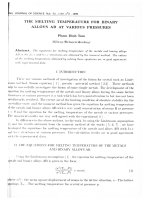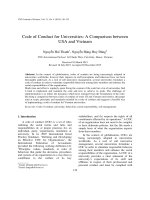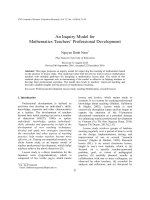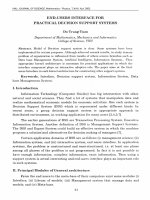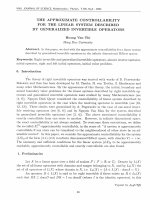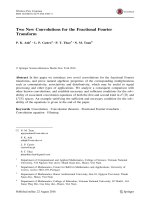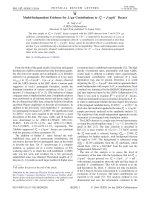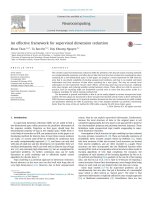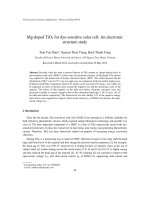DSpace at VNU: Enhacing ICT-enbedded competences for final year teacher education students using a Project-based learning method
Bạn đang xem bản rút gọn của tài liệu. Xem và tải ngay bản đầy đủ của tài liệu tại đây (107.94 KB, 15 trang )
Enhancing ICT-embedded competences for final year teacher education
students using a Project-based Learning (PjBL) method: A case study of at
the Faculty of Education, Vietnam National University, Hanoi
Ton Quang Cuong
Faculty of Education, VNU, Hanoi
1. Abstract
This study examines the context of using ICT in 2 classes of 4th year students in
Faculty of Education, Vietnam National University (VNU). This action research
study is focused on the new way of implementing and enhancing ICT skill training
with combination of Project-based learning methods. Despite their weak ICT skills,
after 15 weeks (one course) they demonstrated the self-confidence of using ICT in
lesson and teaching portfolio designing, as well as in teaching activities. It has
been shown the idea that “why/how we use ICT skill in teaching-learning
process?” is more important than which set of ICT skill we provide students.
2. Introduction
Nowadays applying ICT in teaching is ever necessary and pressing. It has become
one of the obligatory requirements for teachers with the announcement “2008 –
2009 is the ICT year in schools and universities in Vietnam” (Instruction of
planning 2008-2009, MOET). The Faculty of Education (VNU) has a “3+1”
teacher education model (they learn fundamental sciences for three years in
universities of VNU, teaching skills for one year in the Faculty). Although in the
program for teacher education in VNU students have subject specialized on
computer skills (3 credits) in the first year, skills at using ICT in teaching obtained
by students from the subject is fairly low. This limit is caused by these main
reasons that follow:
- ICT skills are taught separately (ICT as an independent subject);
- Students’ awareness and activeness in integrating ICT in learning
process is still low;
- Learning tasks and used-in-university teaching methods do not
encourage students in using ICT (Ineffective teaching methods:
lectures, presentation of factual knowledge, rote memorization, little
use of homework, not much faculty-student interaction; Student
learning is passive (listening memorized information on exams) [8,
pp: 20-22]; and
- Material facilities are lower than required etc.
For these reasons it is necessary to suggest a new approach for developing subject
teaching in accordance with integrating, practicing, and enhancing ICT skills
through using ICT-based teaching methods and implementing learning tasks.
The purpose of this study was to define the new approaches in enhancing ICT
skills for students in teacher education. ICT skills could not be enhanced only
1
separately (as before) but might better be integrated into new a form and method
of learning with motivated and inspirational activities for learners. This means that
central focus is how to help students to develop teaching competences using
embedded ICT techniques by the way of authentic task in project-based learning
method (PjBL). Also, such strategies will also model active learning practices for
would-be teachers.
The complex of teaching ICT-embedded competences in PjBL should be
developed as follows:
- Building learning resources preparation competence (C1);
- Content presenting (delivering) competence (C2); and
- Assessment competence (C3).
The set of ICT skills which will be developed is:
- Using searching tools (U1): Internet (e-mail) and search engine;
- Using presenting tools (U2): Word-processing, MS PowerPoint with
integrating Multimedia, Publisher etc.; and
- Using social sharing tools (U3): e-mail, Moodle platform.
3. Research questions:
This study attempted to find out the answer for the following research questions:
- How ICT skill training can be integrated with Project-based learning using
the (PjBL) method?
- How do students improve ICT skills by the way of PjBL?
- How PjBL, using embedded ICT can create a new effective learning
environment?
4. Approaches and methods of study:
This study was conducted using the PjBL method with using ICT skill training
content for two groups of 4th year student teachers (N=94) in History and
Vietnamese-Literature education, Faculty of Education, VNU). The course was
named Teaching-learning Methodology and Technology, two credits (total of 30
credit hours over 15 weeks).
Approaches
The following approaches were planned:
- A delivery system: to improve the lesson preparation, lesson content design,
teaching portfolio design and creating learning resources with using multimedia;
- A set of ICT skills: to enhance competences of using ICT for students in
teaching-learning process and inside/outside classroom activities (preparation,
actualization, practice, assessment and evaluation); and
- A catalyst for a new form and environment of teaching-learning: to apply
the PjBL method, learner-centered approaches and competence-based learning
(CBL) with Authentic task (assessment).
Methods
2
A questionnaire with 15 items around ICT skills and teaching competencies, nontraditional forms of teaching and expectations was delivered to 94 students in
teacher History and Vietnamese-Literature education classes;. Interviews were
undertaken systematicalyfor sharing different concepts and tendencies with
students and colleagues, also with secondary education teachers. Observation and
records from these observation of classes provided consistent feedback for keeping
the learners’ progress during their different learning tasks (including authentic
tasks)A diary (classroom journal) was used for record keeping of the students’
learning progress and feedback from the two classes over the 15 weeks.
5. Review of Literature
Students who enter school are communicative, curious, creative, and
capable of learning many things. They have proved this already by
mastering a mother tongue, physical motion, complicated games, and
many other life skills. However, we believe that the traditional school of
the 20th century, which is still very much with us, diminishes these
abilities over the period of learning. We need a new kind of school for the
21st century (UNESCO, 2005, p. 20).
Peter Van Gils (2003) in his report which investigated lower- and upper-secondary
school concerning ICT use in Vietnam provided a new vision of ICT role in
education. The key elements were:
- ICT play dual role and function in learning process: as a learning
object and tools;
- ICT as facilitator for creating effective learning environment; and
- ICT as open social and communication tools between teacher,
learner and educational manager.
He also suggested a new platform for effective use of ICT in schools, including
kindergarten, primary and secondary, in the North Vietnam. Especially, this study
concerns the new role of teachers and students in terms of students’ learning and
social responsibilities. Gils (2003) emphasized that the learning responsibility
must be transformed to learner to (1) construct new knowledge for themselves, (2)
design learning plans, (3) create reflective activities, (4) communicate and share
with others etc. All elements of this new responsibility have to be “deeply”
embedded in ICT learning environment (Peter Van Gils, 2003).
Gils (2003) also proposed a new way of teaching (facilitating students’ learning)
that was in stark contrast to custom and practice (traditional teacher-centred) in
Vietnamese schools by the way of reducing inside class time and providing more
authentic learning interdisciplinary tasks with PjBL method ICT-embedded skills
and environment. He stated an important understanding for teacher educators in
Vietnam especially including those in ICT teacher education.
3
In this context with the similar idea, Tan Seng Chee (2003) stated the new role of
teacher in ICT context: teacher as presenter, teacher as facilitator and teacher as
designer. With new concept of using ICT teachers could then create rapid
opportunities for breaking the barriers of time and space, making learning more
motivating and inspirational, flexible and wide accessible.
All learner and teacher activities are constructed in this research process followed
the behavioral theory of learning proposed by B.F. Skinner (1976), which
suggested:
- If stimulus and response are constructed the right way, they may lead
students to success and skills;
- Students remember and respond, practice with changing in overt behavior,
skills due to conditioning (authentic task and assessment/self-/co-/peerassessment); and
- The teacher plays the role of designer, presenter, facilitator and assessor.
The main principles for learning mode were:
- Less direct instruction, more guided inquiry and discovery learning for
students;
- Encouraging more social communication (pair and group work);
- Providing common information tools for individual constructive tools
based on students needs and competence; and
- Maximum instruction for individual competence to construct new
knowledge. (See Figure 1 below.)
Discovery
Learning
Social
Constructive
Tools
Individual
Constructive
Tools
ICT Tools
Guided
Inquiry
Individual
Instructive
Tools
Social
Communicative
Tools
Figure 1: The Mode of learning with ICT
In this study the NETS-2008 (National Educational Technology Standards)
developed by the International Society for Technology in Education (ISTE 2008)
for teachers and students also are used as a guide to investigate new
implementation
opportunities
in
teaching
process
in
our
case
4
( Based on these standards
a different learning task (including authentic) are created for students toward to
three course competencies (C1, C2, C3).
Furthermore, in 2008 Hanoi Department of Education and Training (DOET)
investigated teachers’ use of ICT skills, that is, their use of computer, Internet, MS
Office in designing and delivering lesson in 60 lower-and upper secondary schools
in Hanoi. The surve y found that although all schools in Hanoi have a connection
with Internet only 32% of teachers use it, Then, 18% of teachers used the internet
for creating learning material and instructional content and only 12% for ICT
skills in designing lesson (including full e-lesson and partly integrating ICT
elements into traditional lesson). Only 27% of surveyed teachers said that they felt
self-confident when using ICT skills in teaching process (using Projector, Smart
Board and computer in classroom).
We understand that the relevance of subject-matter will be meaningful and
strengthened by integrating in each course “knowledge motivation and
acquisition” and “knowledge application” (based on Skiner theory and Davis
Technology Acceptance Model). The transformation of knowledge acquired into
the “ability/competence to apply” is an explicitly chosen objective in each course
at Faculty of Education, VNU, Hanoi.
In education and learning literature there are multiple definitions of student
learning outcomes, objectives, skills, competencies, and so on. In this study, there
is the use of the NPEC work group’s definition of competency: “a combination of
skills, abilities, and knowledge needed to perform a specific task” (U.S.
Department of Education, 2001, p. 1). Thus, it could be re-stated as: “competency”
is the capability to choose and use (apply) an integrated combination of knowledge,
skills and attitudes with the intention to realize a task in a certain context. Personal
characteristics such as motivation, self-confidence, and other life skills also are
part of that context.
Regarding the idea of the authentic assessment task, Wiggins (1993) stated its
purpose as involving engaging and worthy problems or questions of importance, in
which students must use knowledge to fashion performances effectively and
creatively. The tasks are either replicas of, or analogous to, the kinds of problems
faced by adult citizens and consumers or professionals in the field" (Wiggins,
1993, p. 229).
5
Figure 2: Scheme of work for developing ICT skills with authentic assessment
How ICT skills and tools can be integrated?
Competence1 + Competence2 + Competence3
Using ICT skill1 + Using ICT skill2 + Using ICT skill3
How can students create and show their
learning projects?
What are characteristics of good
performance on the tasks?
How can indicators be described and
classified in measurable terms to indicate
students’ level of competence?
So, it is clear that our 4th year teacher education students have different reasons
and ways to develop ICT skills. And to be knowledgeable, able to apply and be
skilled is an explicitly chosen objective of this course and the key to effective
using ICT in their teaching process in the future. The following formulation restates this as an equatioo:
Competence based Learning + Authentic Task + ICT skills = New Success
6. Situational Analysis
The study highlighted a number of issues regarding to students’ use of ICT in
and/or out class time, their requirements in term of attitude and motivation. The
baseline data indicated:
- ICT as a separate subject in teacher training programs is still seen as an
extra and add-on rather than integrated and needed for teaching skills.
“Teaching ICT” is as separated content;
6
-
-
-
-
Students obtain only separate ICT skills, but they cannot apply the ICT
skills for their learning because they have not motivation in using ICT for
implementing their tasks and assignments, they also simply practice the
ICT skills they have learned;
Most students have Internet and email-using skills but use them only for
entertainment, they do not know how to use these skills in order to search
information and build learning resources;
Students have no access to ICT presenting tools;
Students are not fully aware of integration ICT in their learning, they are
also not given ICT instructions and ICT-applying principles in their
learning;
They are fairly weak at group-work skills as well as sharing information;
Although classes equipped computers are not available, students always
can use other cheap resources out of class time (around 15 US cents per
hour for using computer and accessing internet in dormitory computer
rooms and Net-café).
7. Planning: Data collection and analysis
In order to carry out the research we gave questionnaires for 94 students in 2
classes of Teaching-learning Methodology and Technology and surveyed their
ICT skill background. The questionnaires were distributed 2two times: at the
beginning of, and after finishing, the above course.
The purposes of the questioners were:
- Survey students’ ICT knowledge and ICT use ability,
- Survey the frequency of using tools researching and exploiting learning
resources,
- Measure the level of ICT skills acquired by students after the course.
In this study the ICT-embedded competencies are based following Technology
Acceptance Model – TAM (Davis, 1989) withh six hypothesis of using, accepting
ICT:
H1: Perceived ease of use is positively related to perceived usefulness
H2: Perceived ease of use is positively related to attitude toward using
H3: Perceived usefulness is positively related to attitude toward using
H4: Perceived usefulness is positively related to intention to use
H5: Attitude toward using is positively related to intention to use
H6: Intention to use is positively related to actual use
7
Perceived
Usefulness
Behavioral
Intention to Use
Actual System
Use
Perceived Ease of
Use
Figure 3: TAM Model . (Adopted from Davis et.al., 1989)
The survey results demonstrate:
- Most students know functions of Microsoft Office (Word, Excel,
PowerPoint), and other tools such as e-mail, Internet, Chat and Window
Media Player, but they often use them with low frequency and mainly for
entertainment like exchanging e-letters with friends, reading e-newspapers,
listening music and so forth;
- Students do not realize the integration function of the mentioned tools in
learning;
- Students do not see themselves as competent at using the tools; and
- Some students do not spend much time for using them at all.
Figure 4: Mean score for students’ self report using ICT skills in teaching-learning
process before the class began
Mean score for use ICT skills
94
100
80
79
43
23
20
16
12
0
W
ik
i
B
lo
g
W
M
P
E
xc
el
e_
m
ai
l
In
te
rn
et
S
ea
rc
h
to
ol
M
S
W
M
or
S
d
P
ow
er
P
oi
nt
P
ub
lis
he
r
0
0
0
C
ha
t
40
82
56
M
oo
A
dl
ut
e
ho
rin
g
to
ol
60
94
90
Tools
Figure 5: The frequency of students’ self report using searching tools by students before
the class began
8
Searching Tool of use
60
50
User
40
<5h
30
6h to 10h
>10h
20
10
0
e_mail
Internet
Google search
e_lib
Tools
Analyzing the above mentioned results leads to some requirements for ICT skill
teaching as follows:
- Ensure that the main ICT tools are directly applied in a teaching-learning
process;
- It is necessary to integrate ICT skills with concrete tasks such as lesson
preparation, content presentation and other classroom activities in learning
process organization;
- Technical help should be available when students need it;
- It is essential not to teach “pure” ICT operations or techniques but “content
of using ICT”.
8. Study description
During the Teaching-learning Methodology and Technology course (lasting15
weeks), ICT skills should be integrated in teaching-learning and implementing
students’ assignments (authentic task).
Students in each class are divided into learning groups (class history education and
literature education has 5 and 6 groups, respectively). At the end of the course
each group of students has to use ICT skills to design a Learning Project and
eventually complete a Teaching Portfolio as a whole (relating to designing and
practicing learning process outcomes). The Teaching Portfolio consists of product
sets as follow:
- Learning resource folder;
- Lesson plan folder;
- Presenting folder; and
- Assessment folder.
During developing the course, students are trained in techniques to use Word
processing, MS PowerPoint, Publisher, Search Engine Tools (Google), using
Internet (Web 2.0), e-mail and sharing tools in Moodle, audio/video editing tools,
Multimedia tools. Students are taught about PjBL method for secondary education.
They also can use materials supported by Intel Teach Program, Partner in
9
Learning Program (Microsoft) containing different instructions for using ICT in
teaching, checklist, worksheets and rubric for assessment. Each group should be
responsible for one learning Project consistent with either the secondary education
program in History and Vietnamese and Literature. Examples would be organizing
a conference about local history, TV Games-show, Advertising Campaign for a
new Tour, Exhibition on life of famous writer, design E-book about life and career
of famous writer or poet etc. In this learning process they have to use media tools
for designing different presentations, making posters, pictures or videoclips,
websites, preparing worksheets, assessments tools, sharing experiences etc. and
for oral presenting and learning competitions.
During carrying out the project, students in each group cast each other for parts,
suggest the idea and tasks for the project by themselves, find suitable ICT tools for
designing products, research materials, practice presentation techniques supported
by technology. In the project ICT skills are used as much as possible. Members in
the learning group support each other in order to enhance ICT as well as to shape
and develop ICT skills for use in learning, share experiences in using ICT, and
require ICT help from their teachers.
During the first period of eight credit hours (in two weeks) the teacher introduced
ICT skills to students and let them practice these skills directly. According to the
questions or requirements about ICT raised by student groups, the teacher
organized short-term training or gives instructions through e-mail and Moodle.
The eacher supports improving ICT for students on basic of their concrete
requirements and particular products that are being completed by them. The
teacher shares time with students for consultation based on real need of learner
with concrete tasks, questions and suggestions from them.
ICT skills use in education is taught by designing correlative ICT skills support
card/worksheet (SC). The technique support cards are in both hardcopy and
softcopy (sharing file in class e-mail or/and Moodle platform). The structure of
each SC consists of four parts; these are instruction, task, idea to apply and
feedback. If a student has some questions, s/he can fill the SC and send it back to
the teacher.
To pass the course successfully student has to complete the required products (see
Table 1). The products have to be packaged for a CD. Different groups of students
present and introduce their products before the rest of the class. The group’s work
is assessed according to three requirements as follow:
- The productivity of each group (the quality and content of Teaching
Portfolio);
- The group’s ability to use ICT in designing the Teaching Portfolio; and
- Presenting their products.
10
Final Product
Learning Resource
Folder
Lesson Plan
Folder
Content
- All needed resource
for Teacher relating
project topic
- All needed resource
for pupils relating
project topic
- Project proposal
- Task Checklist for
group members
- Poster
- Other: Invitation
recommendation letter,
scenario etc.
- Teaching plan
- Description for each
activities
- Lesson plan with PjBL
Format
- Printed
- Digital
- Photo
- Video clip
- Audio file
- Web
Tools
- MS Word
- MS PowerPoint
- MS Publisher
- Web 2.0
- Window Media Player
- Authoring Tools: VCD
Cuter, Proshow Gold 2.0
software
- Printed
- Digital
- Web
- MS Word
- MS PowerPoint
- Moodle
- Camera
- Presentation
products
- Set of posters
- Set of accessories
- Printed
- Digital
- Web
- MS Word
- MS PowerPoint
- MS Publisher
- Web 2.0
- Window Media Player
- Authoring Tools: VCD
Cuter, Proshow Gold 2.0
software
- Rubric
- Protocol
- Checklist
- Report
- Record score
- Presentation: structure
and techniques
- Communication skills
- Competence of
integration using ICT
techniques
- Printed
- Digital
- Web
- MS Word
- MS PowerPoint
- Moodle
- Performance
- Individual and group
activities
- MS Word
- MS PowerPoint
- MS Publisher
- Web 2.0
- LCD Projector
Presenting Folder
Assessment Folder
Group Project
Presentation
Table 1: Learning task instruction
Assessment is carried out openly and directly during lesson time through the
teacher’s assessment and self-/pair-/co-assessment. A very good Teaching
Portfolio will be put also forward to Intel Teach Program (Intel Education
Vietnam) for awarding Certificate of Completion Course on the Effective Use of
Technology in Subject Teaching and Qualification as Teacher Educator under The
Intel® Teach Program.
9. A summary of findings
The results of study showed that:
11
-
The groups of students were interested in learning “content of using ICT” in
learning process. There were various ICT use ideas. Students asked many
questions about ICT skills relating to teaching developing ideas (totally 502
questions ware posted during ten weeks of learning). Teacher became their real
guider and facilitator.
- The communicative process was developed appropriately and effectively.
Allocating and implementing task passed under close control. Each member
had chances to promote their learning competence and own experiences.
- The set of ICT skills and techniques is less important than the need, priorities,
motivation and new idea of its using during doing authentic task process.
- The use of ICT really forces new learning environment: non-traditional form of
learning, non-linear learning process, more outside classroom activities
(students spent about more than two extra-class hours per day averagely; group
work time was obviously increasing outside class; more questions towards
learning program from students etc.).
- Despite of different level of acquired ICT skills, students feel confident and
enjoyable with learning task: the final product show became a real festival
competition in both two classes.
- The best way of enhancing ICT skills for students is making “content of using
ICT” reasonable, motivated and creative with authentic task (assessment).
- Learning process creates new opportunities for self-/pair-/peer-assessment:
students could control and manage their progress step by step (by various
Rubrics).
- Multiple subject content in secondary program (in this case there are History
and Vietnamese-Literature) can be taught by the way of Project-based
Learning method with integration ICT.
10. Discussion
On the basis of analyzing the study’s questions and results it can be concluded that
teaching ICT skills is fairly “easier” than teaching “ICT skills in teaching” because
ICT skills must be integrated into teaching skills according to the teaching
principles. The difficulty (or should be paradox) in process of enhancing ICT
skills for future teachers is how to ensure them access to technical support and at
the same time how to ensure that they do not feel becoming technical specialist
themselves at all.
Acquired ICT skills for teacher-students are only primary condition and fist step in
the way of learning to teach. The pivotal mechanism of enhancing ICT skills for
future teacher must be:
- How to design ICT based lesson?
- How to realize ICT based lesson (learning activities and materials)?
- How to assess and evaluate ICT based lesson?
11. Conclusions
12
Once again, the study showed new challenges for teachers as designer, presenter,
facilitator, assessor, and overall reflective practitioner. This small-scaled research
also could provide for faculty initiatives of enhancing ICT skills by the way of
using competence-based learning for students, creating non-traditional learning
environment for authentic task and creativeness for them. One of the greatest
overriding lessons learned from this study is to provide sufficient amounts of
professional competences and authentic tasks to activate creative “learning space”.
Of course in this “space” we always can “fill up” the ICT skills and idea of its
using. In the words of one 4th year student (class of History education): “Bài tập
môn này khó quá nhưng em vẫn chấp nhận khó khăn một cách rất thoải mái”
(learning tasks of this course really are challenging but I felt ‘fully comfortable
unpleasantness’ to do it)”.
12. References
In Vietnamese
1. Teaching-Learning Methodology and Technology. A Guidebook for Teacher.
Faculty of Education, VNU, Hanoi, 2008.
2. DOET Hanoi: Annual Report of teachers’ Action Research. Hanoi, 2008
3. Project material VVOB-IMIH. Vietnam, 2003
4. Guidebook for using ICT in learning. Intel Teach Program. Intel Vietnam, 2008
5. Guidebook for integration ICT into learning. Partner in Learning Program.
Microsoft Vietnam, 2007.
In English
6. Davis, F. D. (1989). Perceived usefulness, perceived ease of use, and user
acceptance of information technology, MIS Quarterly, 13, 31-340.
7. Information and Communication Technologies in School. A guide book for
teachers. UNESCO, 2005.
8. Observation on Undergraduate Education in Computer Science, Electrical
Engineering, and Physics at select Universities in Vietnam. A Report presented to
the Vietnam Education Foundation by the Visit Team of the National Academies
of the United States. Hanoi, Aug. 2006
7. Peter, G.Cole & Lorna K.S. Chan. Teaching Principles and Practice. Prentice
Hall, 1994
8. Tan, S.C (Ed). Teaching and Learning with Technology. An Asia-Pacific
Perspective. Prentice Hall, 2003.
9. Wong, A.F.L. Instructional Planning. Integrating technology into teaching and
learning: concepts and applications. An Asia-Pacific perspective. Prentice Hall,
2000.
10. Wiggins, G. P. Assessing student performance. San Francisco: Jossey-Bass
Publishers, 1993.
13
11. Wiggins, G. P. Educative assessment: Designing assessments to inform and
improve student performance. San Francisco: Jossey-Bass Publishers, 1998.
12. Defining and Assessing Learning: Exploring Competency-Based Initiatives.
Report of the National Postsecondary Education Cooperative Working Group on
Competency-Based Initiatives in Postsecondary Education. US Department of
Education, 2002.
In Russian
13. Khutorskoi A.V. Modern Didactic. Moscow, 2006.
On Internet
www.unescobkk.org/education/ict
/> /> /> /> />
Appendixes
1. Learners’ needs questionnaire
2. Rubric of assessment
3. ICT support card
14
15

